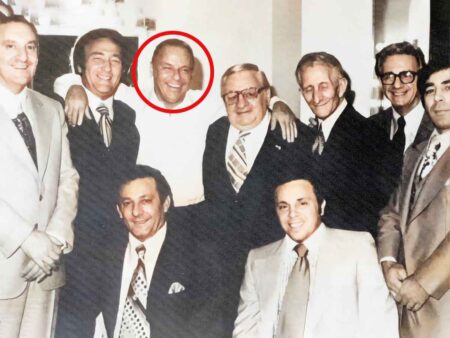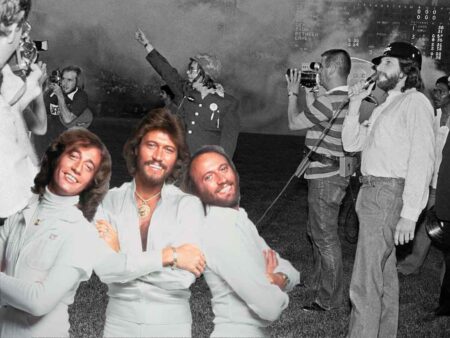After decades of public life, personal tragedy, and relentless creative output, Barry Gibb chose an unconventional path for healing—ten days of complete silence. He entered a silent retreat not as a celebrity gesture, but as a deeply personal reset. In the absence of noise, Barry was able to confront the emotional toll of losing his brothers, and the weight of being the last Bee Gee.
In an interview with BBC Radio 2, he described this experience as transformative, giving him time to rediscover his sense of self and his creative purpose.
The retreat helped spark the inspiration for Greenfields, a 2021 album that reimagined Bee Gees classics with a country twist. The project resonated deeply with fans and topped charts in the UK and Australia, proving Barry’s music still had new stories to tell—even after six decades in the business.
Contents
The Falsetto That Carried a Generation
Barry’s falsetto wasn’t simply a technical marvel—it became the signature sound of a cultural moment. While the Bee Gees were originally known for orchestral ballads in the ’60s, the mid-’70s brought a bold reinvention. Barry began layering his falsetto across lead and background vocals, helping shape the sound of hits like Stayin’ Alive and Night Fever. These tracks became global anthems of the disco era.
Even without formal training in music theory, Barry had an instinctive command of melody and harmony. As Rolling Stone noted, the Gibb brothers worked entirely by ear, relying on studio engineers to help translate their intuitive approach into polished tracks (Rolling Stone).
A Pen That Crossed Genres and Generations
While his voice captivated millions, Barry’s songwriting proved even more influential. He has written or co-written over 1,000 songs, and in 1978 alone, his compositions spent more than half the year at No. 1 on the Billboard charts. That same year, he became the first songwriter to score four consecutive U.S. No. 1 hits, a feat that has rarely been matched.
Beyond the Bee Gees, Barry’s writing fueled the careers of countless artists—from Barbra Streisand and Kenny Rogers to Diana Ross and Dolly Parton. According to GQ, he wrote more U.S. chart-toppers in 1978 than anyone else, making him the most dominant songwriter of the year.
His ballads, in particular, blended pop sensibility with emotional depth, making them staples of wedding playlists and radio dedications for decades.
More Than a Disco Icon
Despite being typecast during the post-disco backlash of the early 1980s, Barry Gibb’s body of work reveals a much wider artistic range. Before Saturday Night Fever, the Bee Gees had already found success with lush, melancholic ballads. And in the decades after disco’s peak, Barry continued to produce and write chart-topping songs.
He is one of only a handful of songwriters to score No. 1 hits across five decades—from the 1960s through the 2000s. His work has touched nearly every genre, including R&B, country, pop, and adult contemporary. As NPR noted, his recent pivot toward Nashville on Greenfields demonstrated just how enduring his songwriting really is.
Barry’s humility and resilience have also shaped his legacy. In interviews, he consistently credits his brothers, his family, and the power of collaboration for his success.
A Legacy of Resilience and Reinvention
Today, Barry Gibb stands not only as the last Bee Gee, but as a rare artist who has managed to remain relevant without ever chasing trends. He’s sold more than 200 million records, won nine Grammy Awards, been inducted into the Rock & Roll and Songwriters Hall of Fame, and was knighted by Queen Elizabeth II.
In a CBS Sunday Morning feature, Barry emphasized that his mission has always been to keep the music alive, not to chase the spotlight.
His music, spanning six decades, remains a living soundtrack for millions. Whether you discovered Barry through Saturday Night Fever, an Andy Gibb duet, or a Streisand ballad, his songs continue to speak to the heart.
Barry Gibb’s Most Iconic Hits (as Performer and Songwriter)
- Stayin’ Alive – Bee Gees
- How Deep Is Your Love – Bee Gees
- Night Fever – Bee Gees
- Too Much Heaven – Bee Gees
- To Love Somebody – Bee Gees
- Islands in the Stream – Kenny Rogers & Dolly Parton
- Woman in Love – Barbra Streisand
- Grease – Frankie Valli
- Shadow Dancing – Andy Gibb
- Emotion – Samantha Sang
- Heartbreaker – Dionne Warwick
- Guilty – Barbra Streisand & Barry Gibb
- An Everlasting Love – Andy Gibb
Each of these tracks represents a different shade of Barry’s artistry—from falsetto-fronted disco to tender ballads and crossover country hits. Together, they showcase the vast emotional range and enduring appeal of his songwriting legacy.




